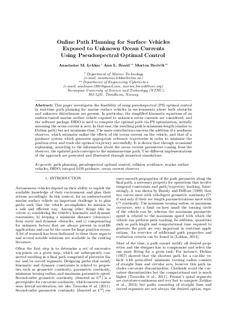| dc.contributor.author | Lekkas, Anastasios M. | |
| dc.contributor.author | Roald, Ann Louise | |
| dc.contributor.author | Breivik, Morten | |
| dc.date.accessioned | 2017-11-08T14:22:01Z | |
| dc.date.available | 2017-11-08T14:22:01Z | |
| dc.date.created | 2016-08-02T11:08:55Z | |
| dc.date.issued | 2016 | |
| dc.identifier.citation | IFAC-PapersOnLine. 2016, 49 (23), 1-7. | nb_NO |
| dc.identifier.issn | 2405-8963 | |
| dc.identifier.uri | http://hdl.handle.net/11250/2465008 | |
| dc.description.abstract | This paper investigates the feasibility of using pseudospectral (PS) optimal control in real-time path planning for marine surface vehicles in environments where both obstacles and unknown disturbances are present. In particular, the simplified kinematic equations of an underactuated marine surface vehicle exposed to unknown ocean currents are considered, and the software package DIDO is used to compute the optimal path via PS optimization, initially assuming the ocean current is zero. In that case, the resulting path is minimum-length (similar to Dubins path) but not minimum-time. The main contribution concerns the addition of a nonlinear observer, which estimates online the effects of the ocean current on the vehicle, and that of a guidance system which generates appropriate reference trajectories in order to minimize the position error and track the optimal trajectory successfully. It is shown that through occasional replanning, according to the information about the ocean current parameters coming from the observer, the updated path converges to the minimum-time path. Two different implementations of the approach are presented and illustrated through numerical simulations. | nb_NO |
| dc.language.iso | eng | nb_NO |
| dc.publisher | Elsevier | nb_NO |
| dc.relation.uri | http://www.sciencedirect.com/science/article/pii/S2405896316319000 | |
| dc.rights | Attribution-NonCommercial-NoDerivatives 4.0 Internasjonal | * |
| dc.rights.uri | http://creativecommons.org/licenses/by-nc-nd/4.0/deed.no | * |
| dc.title | Online Path Planning for Surface Vehicles Exposed to Unknown Ocean Currents Using Pseudospectral Optimal Control | nb_NO |
| dc.type | Journal article | nb_NO |
| dc.type | Peer reviewed | nb_NO |
| dc.description.version | acceptedVersion | nb_NO |
| dc.source.pagenumber | 1-7 | nb_NO |
| dc.source.volume | 49 | nb_NO |
| dc.source.journal | IFAC-PapersOnLine | nb_NO |
| dc.source.issue | 23 | nb_NO |
| dc.identifier.doi | 10.1016/j.ifacol.2016.10.313 | |
| dc.identifier.cristin | 1370061 | |
| dc.relation.project | Norges forskningsråd: 223254 | nb_NO |
| dc.relation.project | Norges forskningsråd: 234108 | nb_NO |
| dc.description.localcode | © 2016. This is the authors’ accepted and refereed manuscript to the article. This manuscript version is made available under the CC-BY-NC-ND 4.0 license http://creativecommons.org/licenses/by-nc-nd/4.0/ | nb_NO |
| cristin.unitcode | 194,64,20,0 | |
| cristin.unitcode | 194,63,25,0 | |
| cristin.unitname | Institutt for marin teknikk | |
| cristin.unitname | Institutt for teknisk kybernetikk | |
| cristin.ispublished | true | |
| cristin.fulltext | postprint | |
| cristin.qualitycode | 1 | |

